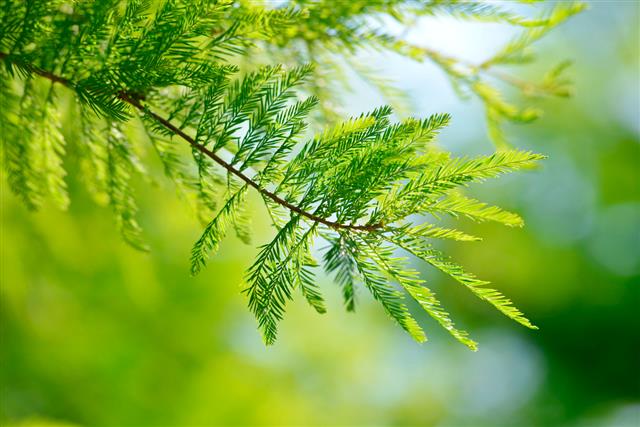
This article tells us the correct procedure on how to grow a bald cypress tree and the various requirements of climate, soil, fertilization, etc. Growing this tree is easy, as it requires minimal maintenance.
The bald cypress tree, scientific name Taxodium distichum, is a deciduous conifer that belongs to family Cupressaceae of the order Pinales. It is native to the southeastern regions of United States. As this tree is adapted to a wet and swampy environment, it is also referred to as swamp cypress. Similar to other deciduous varieties, it sheds foliage in the fall season, leaving a bald structure. If maintained properly, their lifespan is expected to be more than 1300 years.
Description
Speaking about the plant description, it is a tall tree that grows to about 75 – 100 feet and attains a girth diameter of about 2 – 3 meters. The growth rate is about 12 – 18 inches per year. The bark is brownish red in color and stringy in texture. The needle-shaped foliage is borne around the stem. Each needle is about 1 – 2 cm long and 1 – 2 mm wide. The growth habit and appearance of this tree resembles that of an evergreen.
Male and female strobili are developed in the same tree (monoecious), which mature after a year. Most of the species produce strobili every year. Fertilization of the male and female gametes occurs in winter, resulting in seed cone formation. The matured seed cone is globular in shape and green in color, which turns grayish brown after maturation. About 20 – 40 triangular seeds are present per seed cone.
Tips for Growing
The bald cypress is a popular landscaping tree, especially due to its attractive pyramidal shape and adaptability to poor nutrient soils and cold climatic conditions. It is also planted as a street tree, as the maintenance is low in comparison to other ornamental deciduous options. This grows best in wet soil and sunny areas. The plant is intolerant to shade conditions. It can be trained properly for creating a bonsai tree. For growing purposes, you can either use seeds or young plantlets.
Germination: The germination takes place when the seeds are exposed to damp and moist conditions for a prolonged time (1- 3 months). Since germination requires a long period, you can opt for the plantation of young seedlings that are available in horticultural shops. You can remove at least half of the burlap that adheres to the root ball before introducing it to the soil.
Soil Preparation and Plantation: Sandy loams are best suited for growing these trees. You can prepare soil in early spring for these trees. Prior to growing the plantlet, prepare the soil by adding farmyard compost and/or organic fertilizer. Following this, dig the soil to such a depth that the root ball can be fitted to the planting hole. For plantation, introduce the root ball in the planting hole, water properly and cover with soil.
Watering: As bald cypress trees are naturally adapted to swampy areas, deep watering should be done regularly, at least every alternate day. In warm climatic regions, the plantlets should be watered twice everyday, once in the morning and once in evening. Many of the hobbyists prefer to keep the plants in submerged conditions during the summer months.
Mulching and Fertilization: Mulching the plantation site is recommended to conserve maximum moisture and control weed growth. You can cover the area with 3 – 4 inch thick mulch. It grows well even without the application of external fertilizers. Nevertheless, if the soil lacks nutrients, you can add organic fertilizers during spring and summer. Fertilization of this tree in winter is not advisable.
Problems: The most common disease that affects this tree is twig blight, that is caused due to infestations by Pestalotia funerea. This fungal pathogen attacks dead and dying trees, especially when the plant is in the dormant state. In order to prevent twig blight, the dead and dry branches should be pruned regularly.
Cypress knees are a characteristic feature of this species, which is an adaptation for growing in water. These are knee like structures that arises above the ground level. As the tree grows in swampy areas, the woods are resistant to water rots. This wood, also referred to as wood eternal, is favorable for making a wide range of outdoor and gardening furniture.



